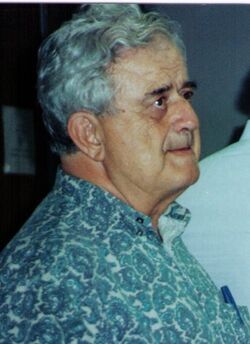Biography:Marshall Rosenbluth
Marshall Rosenbluth | |
|---|---|
 Rosenbluth in 1994 | |
| Born | February 5, 1927 Albany, New York, US |
| Died | September 28, 2003 (aged 76) San Diego, California, US |
| Alma mater | Stuyvesant High School University of Chicago Harvard University |
| Known for | Plasma Physics Rosenbluth potentials Metropolis algorithm Rosenbluth formula |
| Spouse(s) | Arianna Rosenbluth Sara Rosenbluth |
| Awards |
|
| Scientific career | |
| Fields | Physics |
| Institutions | General Atomics UC San Diego Princeton University University of Texas at Austin |
| Doctoral advisor | Edward Teller |
Marshall Nicholas Rosenbluth (5 February 1927 – 28 September 2003) was an American plasma physicist and member of the National Academy of Sciences,[1] and member of the American Philosophical Society.[2] In 1997 he was awarded the National Medal of Science for discoveries in controlled thermonuclear fusion, contributions to plasma physics, and work in computational statistical mechanics. He was also a recipient of the E.O. Lawrence Prize (1964), the Albert Einstein Award (1967), the James Clerk Maxwell Prize for Plasma Physics (1976), the Enrico Fermi Award (1985), and the Hannes Alfvén Prize (2002).
Key scientific contributions
During his first post-doctoral position at Stanford University (1949–1950), he derived the Rosenbluth formula, which was the basis of the analysis used by Robert Hofstadter in his Nobel prize-winning experimental investigation of electron scattering. Hofstadter refers to this in his 1961 Nobel Lecture: "This behavior can be understood in terms of the theoretical scattering law developed by M. Rosenbluth in 1950".
In 1953, Rosenbluth derived the Metropolis algorithm,[3] based on generating a Markov chain which sampled fluid configurations according to the Boltzmann distribution. This algorithm was first presented in the paper "Equation of State Calculations by Fast Computing Machines",Cite error: Closing </ref> missing for <ref> tag and graduated from Stuyvesant High School in 1942.[4] He did his undergraduate study at Harvard, graduating in 1946 (B.S., Phi Beta Kappa), despite also serving in the U.S. Navy (1944–46) during this period. He received his Ph.D. in 1949 from the University of Chicago.[5] In 1950 his doctoral advisor Edward Teller,[6] who is considered the father of the hydrogen bomb, recruited Rosenbluth to work at Los Alamos.[7] Rosenbluth maintained this position until 1956. The research he conducted at Los Alamos led to the development of the H-bomb.
... Rosenbluth went to the South Pacific to prepare for the first H-bomb test. He had trouble sleeping, and was pondering the bomb design when he realised the scientists had made a calculating error that could result in a dud. The flaw was remedied by modifying the detonator, and the bomb vaporised a mile-wide island with a power 700 times greater than that of the atom bomb dropped on Hiroshima in 1945.[8]
Additional information
Upon his retirement, he took on the responsibility of chief scientist of the Central Team for the International Thermonuclear Experimental Reactor (ITER) until 1999. Rosenbluth also served as a member of the JASON Defense Advisory Group.
Rosenbluth was affectionately known as the Pope of Plasma Physics in reference to his deep understanding of the field.[9]
Notes
- ↑ "M. N. Rosenbluth". http://www.nasonline.org/member-directory/deceased-members/51071.html.
- ↑ "APS Member History". https://search.amphilsoc.org/memhist/search?creator=Marshall+N.+Rosenbluth&title=&subject=&subdiv=&mem=&year=&year-max=&dead=&keyword=&smode=advanced.
- ↑ J.E. Gubernatis (2005). "Marshall Rosenbluth and the Metropolis Algorithm". Physics of Plasmas 12 (5): 057303. doi:10.1063/1.1887186. Bibcode: 2005PhPl...12e7303G. https://zenodo.org/record/1231899.
- ↑ Larry R. Faulkner; Sue Alexander Greninger (2004-09-24). "In Memoriam - Marshall N. Rosenbluth". UT Austin. http://www.utexas.edu/faculty/council/2004-2005/memorials/rosenbluth/rosenbluth.html.
- ↑ G. Segrè and B. Hoerlin, The Pope of Physics, Picador 2016, pp. 268
- ↑ "Rosenbluth, M. N.". https://history.aip.org/phn/11608036.html.
- ↑ Teller, Edward, The Work of Many People, Science, New Series, Vol. 121, No. 3139 (Feb. 25, 1955), pp. 267-275, page 271
- ↑ Wright, Pearce (4 October 2003). "Obituary. Marshall Rosenbluth". The Guardian. https://www.theguardian.com/news/2003/oct/04/guardianobituaries.highereducation1.
- ↑ Kim A. McDonald, Nuclear Fusion Pioneer At UC San Diego Dies At 76 , obituary at the University of California website. Retrieved 2008-07-08.
References
- J.W. Van Dam (Ed), From Particles to Plasmas: Lectures Honoring Marshall N. Rosenbluth, Addison Wesley (1989) ISBN:0-201-15680-6.
External links
- 1994 Audio Interview with Marshall Rosenbluth by Richard Rhodes Voices of the Manhattan Project
- University of Texas Memorial Text
- Marshall N. Rosenbluth Papers MSS 670. Special Collections & Archives, UC San Diego Library.
- Rosenbluth Award
 |

